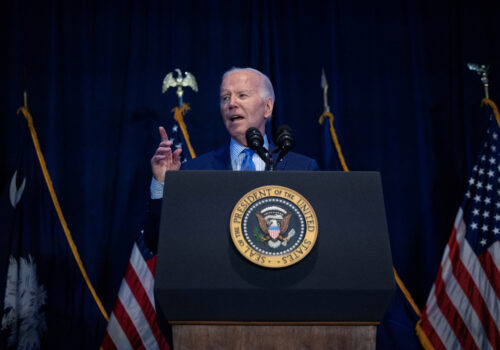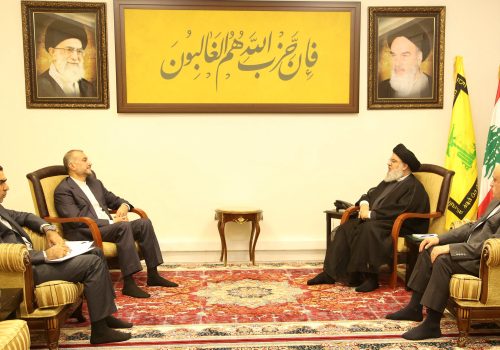Iran is on its way to replacing Russia as a leading arms exporter. The US needs a strategy to counter this trend.
The latest reports regarding the sale of Iran’s Mohajer-6 Unmanned Aerial Vehicles (UAVs) to the Sudanese Armed Forces (SAF) for use in the Sudanese civil war, which has been raging for the past year, should not surprise those who follow Iranian arms sales.
In recent years, and even more so in the last year alone, Iran has been increasing the pace of its sales and transfers of UAVs to various parts of the globe, including Ethiopia, Bolivia, Venezuela, and Western Sahara’s Polisario Front. Iran is well on its way to becoming a leading arms exporter globally, especially since additional countries are interested in buying these capabilities.
The economic profit Iran receives in this regard is clear. It is estimated that the cost of the popular Shahed-136 is $20,000-$40,000 for one unit. This fact, together with the reports that Iran sold more than two thousand drones to Russia alone, makes it clear that Tehran earns millions of dollars from these transactions. However, Iran obtains more than financial gains from this dynamic, as it also deepens the Islamic Republic’s political foothold in these countries, creating dependence on the former and its products.
In this context, Iran has significant advantages compared to countries like the United Kingdom, Israel, or the United States, which export similar capabilities worldwide. Iran’s drones and other military capabilities, such as Fateh-110 short-range missiles, are cheaper than its Western competitors. On top of that, Iran has no political or legal restrictions that prevent it from selling these weapons around the world; it is apparently not afraid that these products will fall into the hands of dangerous foreign parties.
Sign up for the the latest updates from the region
Most importantly, Iran’s products have been proven on the battlefield, whether it has been through Russia’s use of them in the war against Ukraine or the terrorist organizations’ use of them under Iran’s auspices, such as Lebanese Hezbollah, Yemen’s Houthis, or the Shia militias in Iraq. The potency of these weapons in the hands of the latter category of actors was evidenced in the January 28 attack on a base in northeastern Jordan, which killed three service members, as well as the start of the “Iron Swords” campaign, when Israel was viciously attacked by the terrorist group Hamas on October 7, 2023.
This situation has allowed Iran to dramatically increase its sales to many countries worldwide, especially to those to which the West has difficulty transferring weapons, such as countries involved in military conflicts or civil wars.
Another relevant factor in this equation is the position of Russia, which was once a leading weapons exporter before experiencing difficulty maintaining its position as a major power after invading Ukraine. The resulting war has consumed vast Russian resources and provoked an array of sanctions, producing a vacuum in the world of arms sales and military equipment in a time of global instability.
As a result, Iran has become more dominant and attractive in the eyes of countries that previously depended on Russia’s supply of military equipment. Furthermore, the current situation can create a joint venture between Iran and Russia that may increase their conventional mutual arms sales due to their high production capabilities.
Iran’s recent activities in this regard are a clear warning of what will happen if it increases its weapons exports. On top of the other problems this trend creates, it must be remembered that giving strategic capabilities to those with problematic decision-making mechanisms/processes may lead to the misuse of said capabilities, which can significantly destabilize various areas of the world.
The recent events in the Bab al-Mandab Strait are an example of these alarming developments; that the Houthis can threaten the maritime routes in the Red Sea and beyond is driven by the fact that they received strategic capabilities, including drones and Coastal Defense Cruise Missiles (CDCMs), from Iran. If Iran increases the spread of these capabilities, it will probably duplicate the situation in the Red Sea in other places around the world.
For this reason alone, the US government should understand the seriousness of these developments. Ignoring this trend could lead to an irreversible situation that might make Iran the leading arms exporter in the world.
There are multiple actions the Joe Biden administration needs to take to prevent this from happening. First, it must significantly increase pressure on Iran’s drone industry by placing more sanctions on relevant entities, thereby preventing companies from sending dual-use components that could be used in the Iranian drone industry and so forth. Such a measure would make it much more complicated and much more expensive to produce these drones.
Imposing economic and political sanctions on any country that acquires military capabilities from Iran or conducts joint military ventures with it, like Tajikistan, will present hefty trade-offs that could act as a deterrent.
At the same time, the Biden administration needs to consider how to facilitate and speed up its own selling capabilities in order to block the infiltration of Iranian weapons into different countries. As the Sudan case proves, states in need will turn to Iran for help even if a diplomatic rift exists (i.e., Sudan angered Iran by deciding to join the normalization process with Israel). In that regard, the United States can consider selling a version of conventional capabilities with a lower classification, including less sensitive technology, with the understanding that selling weapons to different countries strengthens their stability and increases their dependence on the US.
As mentioned before, the perceived effectiveness of Iran’s drones is bolstered by their use in various combat arenas around the world. The recent tragic event in Jordan, where Kataib Hezbollah wielded an Iranian Shahed drone, further highlights the need to increase the focus on Iran’s UAV industry and its distribution around the Middle East, especially its proxies, in order to prevent these weapons from becoming attractive to countries and organizations that will use them to harm US interests around the globe.
The Biden administration must build a plan aimed at undermining this perception. For example, the Pentagon claimed that the missiles fired from Iran toward Syria on January 15th were inaccurate. If the credibility of Iran’s drones is damaged, it will cause countries to question the benefit of buying from Tehran.
The worst thing the Biden administration can do is ignore the disturbing development of Iran’s weapons transfers in favor of focusing on other negative features of its activities, be it its nuclear program or regional proxies. The US must understand the seriousness of the situation: without active measures, it will be extremely tough to stop Tehran from becoming a world leader in arms sales, not to mention all the negative implications for international stability that would accompany such a reality.
Danny Citrinowicz served for twenty-five years in a variety of command positions units in Israel Defense Intelligence (IDI), including as the head of the Iran branch in the Research and Analysis Division (RAD) in the Israeli defense intelligence and as the division’s representative in the United States. Follow him on Twitter: @citrinowicz.
Further reading
Thu, Dec 7, 2023
Does the Resistance Axis believe its propaganda about Israel? The October 7 attack seems to suggest so.
IranSource By
For the Resistance Axis, portraying Israel as a temporary entity that will inevitably melt away has an obvious utility, and is one that furthers the goal of destroying the Jewish state.
Sun, Jan 28, 2024
Experts react: Three US servicemembers were killed in Jordan. Will the US strike back at Iran?
New Atlanticist By
More than 150 attacks on US forces in the Middle East have occurred since October 2023, but the strike overnight was the first to kill a US soldier.
Thu, Oct 19, 2023
Israel misread Iran’s way of war. A proper understanding could help predict Hezbollah’s next moves.
IranSource By David Daoud
Iran—through Hezbollah—has spent almost two decades and considerable effort and funds building the Gaza Strip into the Axis of Resistance’s Southern Front against Israel.
Image: A view of a drone during a military exercise in an undisclosed location in Iran, in this handout image obtained on August 24, 2022. Iranian Army/WANA (West Asia News Agency)/Handout via REUTERS ATTENTION EDITORS - THIS IMAGE HAS BEEN SUPPLIED BY A THIRD PARTY.


